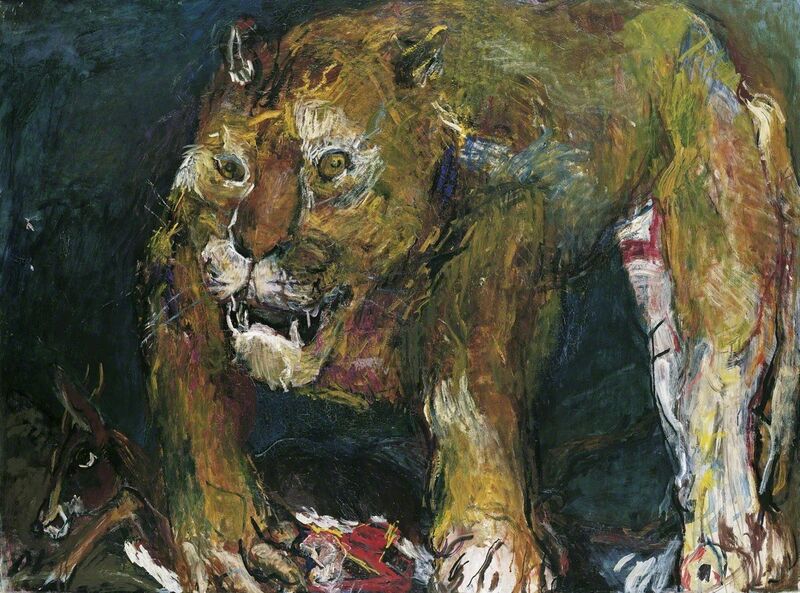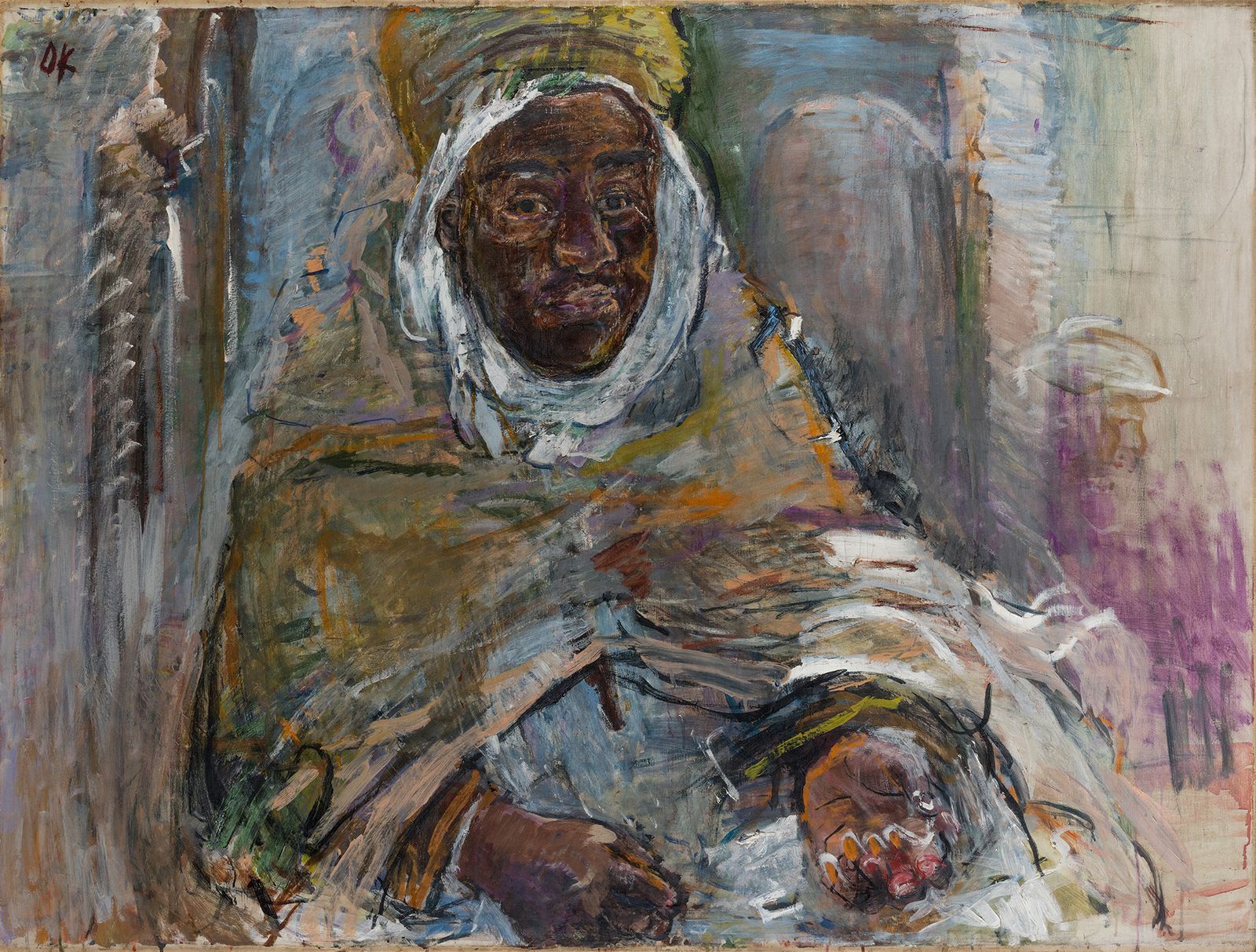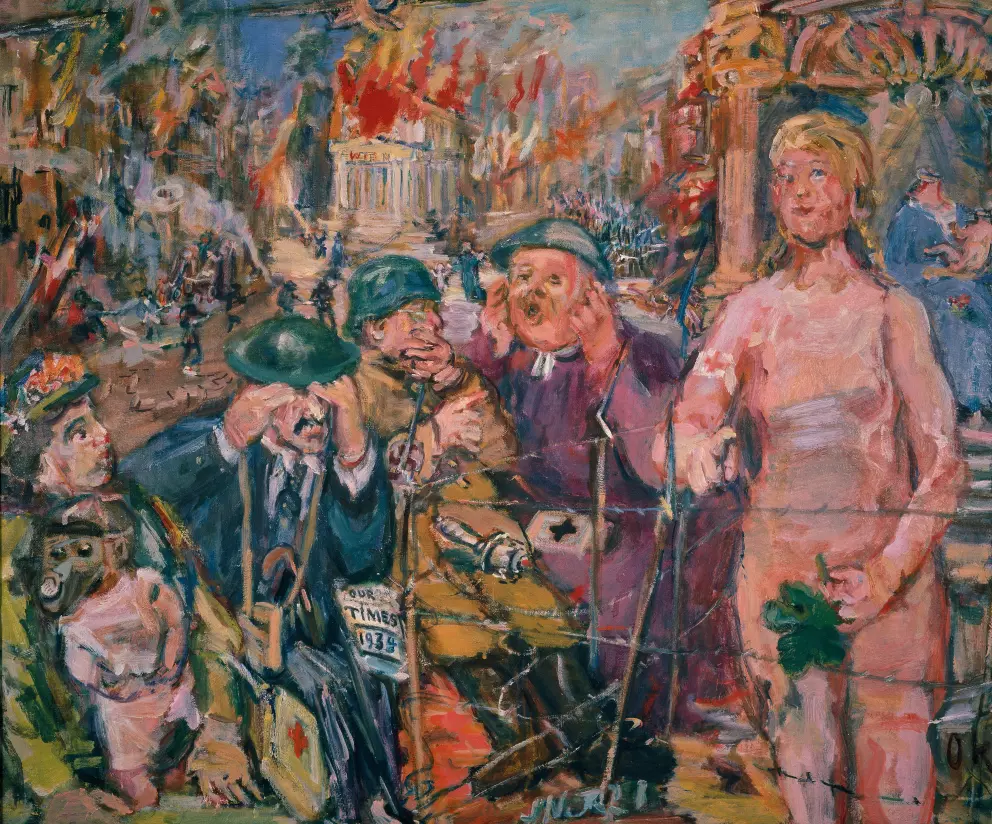- Guggenheim Museum Bilbao
- Curators: Dieter Buchhart and Anna Karina Hofbauer in collaboration with Fabrice Hergott and Fanny Schulmann
Leaving classical ideals behind, Kokoschka used the genre of portraiture as an analytical instrument capable of revealing the model’s inner self.
In Kokoschka’s works, representations very loosely match the forms represented and everything dissolves into pure, dazzling colors.
Kokoschka stands out for his extraordinary commitment to pacifism in his belief that “The artist must serve as a warning”.
The Guggenheim Museum Bilbao and the Musée d’Art Moderne de Paris, Paris Musées present Oskar Kokoschka. A Rebel from Vienna, a major retrospective devoted to the Austrian artist considered one of the fathers of Viennese modernism.
Oskar Kokoschka (b. 1886; d. 1980) garnered early success in Vienna’s art scene, where he was backed by Gustav Klimt, exerted an influence on Egon Schiele when the latter was young, and achieved international renown at the end of his career after the two world wars. By the waning days of World War II, Kokoschka was calling for a united Europe, and his late production left its mark on the Neue Wilde, the new painting in Austria and Germany. Even though he dabbled in a wide range of activities, from theater to political activism and writing, the common thread throughout his life was art.
The cross-border, almost nomadic character of Kokoschka's biography is of enormous importance to his pictorial evolution. His early, radically innovative brushwork at the end of the first decade of the 20th century caused a huge stir in the Viennese art scene and earned him a reputation as a rebellious artist.
Following his participation in World War I (he was seriously wounded at the front in 1915) and a long stay in Dresden, Kokoschka began travelling around Europe, North Africa, and the Middle East, which led him to extend his techniques and expressions as a portraitist to landscape painting, and to produce what he defined as "animal portraits".
In the 1930s, Kokoschka made his art a tool of resistance, in a fierce defense of moral, social and artistic freedom against the rise of Nazism. His images turned allegorical, and among the earliest of these is the lithograph Help the Basque Children! against the Spanish Civil War. He was forced to flee Austria after witnessing how the regime would confiscate more than 400 of his works, and established himself in Prague and London, from where his political and social commitment intensified.
In this period of exile, Kokoschka was one of the first public figures to support a common project for Europe, promoting the unity of its peoples and appealing to human conscience. He also foresaw some of the dangers of the second half of the 20th century, such as economic crises and the nuclear threat. After World War II, Kokoschka moved to Switzerland, where he continued to produce very mature works that also influenced new pictorial movements, up to his death in 1980.
An “enfant terrible” in Vienna (1907-1916)
Inspired by the vibrant atmosphere of pre-World War I Europe, Kokoschka’s early works are radical in their motives, lines, and experiments with color. The human body and its means of expression are the main subjects of Kokoschka’s early drawings. The artist captures the models' movements on paper with subtle yet expressive lines. Kokoschka increasingly abandons the decorative style of Viennese Art Nouveau in favor of sharp angular lines that give the bodies their extraordinary quality. The impact of this new style is reflected in the strong influence it had on colleagues like Egon Schiele, but also in the reactions of the shocked Viennese public. The drawings, therefore, mark the beginning of Kokoschka's radical critique of artistic conventions and traditional bourgeois worldviews.
After his breakthrough at the Vienna Art Exhibition in 1908, Kokoschka began an intensively creative period. The young artist received countless portrait commissions thanks to Adolf Loos, one of his earliest patrons. Subsequently, Kokoschka created numerous paintings in which he explored his full potential and consolidated his reputation as an enfant terrible. Leaving classical ideals behind, Kokoschka uses portrait painting as an analytical instrument that can reveal the inner self of the sitter. He abandons the concrete backgrounds in favor of diffuse color spaces from which the portrayed emerge with unparalleled immediacy. Like in his drawings, he proves his extraordinary ability to capture mental states on canvas.
Oskar Kokoschka and composer Alma Mahler met in Carl Moll's house. As she notes in her autobiography, he was a guest there in April 1912 and drew her while she played the piano. After another meeting two days later, Kokoschka sent her the first of at least four hundred love letters. In the years between this tender beginning and the bitter end that the stormy relationship was to take, Alma became Kokoschka’s most famous muse. Numerous portraits bear witness to his fascination with her. His obsession culminates in the well-known doll that Kokoschka had made during his time in Dresden.
The Dresden Years (1916–1923)
Shaken by his breakup with Alma Mahler in 1914, with whom he had a tumultuous relationship Kokoschka joined the army at the outbreak of the First World War. He was seriously wounded twice. He then moved to Germany. He stayed in Berlin until the end of 1916, where he signed a contract with the gallery owner Paul Cassirer (1871-1926). While going through a period of profound depression due to the war, he received care in a convalescent home in Dresden. He quickly gained a foothold in the art scene and received a professorship at the Academy of Fine Arts in Dresden. The subsequent years should prove particularly fruitful for Kokoschka's artistic work. The paintings of this period stand out due to the rapidly applied and intense colors. They are skillfully juxtaposed, and thus, their intensity is heightened. These paintings only loosely adhere to the forms of the depicted, and everything is dissolved in pure, dazzling colors. Figures and objects oscillate between manifestation and dissolution. The strongly coarsened light and shadow areas, which meet without transitions, further contribute to this stunning effect. Therefore, the masterpieces of the Dresden years are among the most outstanding in Kokoschka's oeuvre.
Journeys (1923–1934)
After his pioneering artistic years in Dresden, Kokoschka gave up his chair at the local academy of fine arts in 1923. The gallerist Paul Cassirer provided Kokoschka with financial support as he traveled across Europe, North Africa, and the Middle East. The landscapes, urban scenes, portraits of people and animals, and other works contrast sharply with the experimental approach he used in Dresden. Kokoschka, who continually reinvented himself, found a new style that differed significantly from traditional painting methods. His landscapes do not aim to reproduce the topography of a given location but rather to capture their atmosphere with unparalleled expressiveness. "I wanted to create space out of colors," he once said.
Often they are shown from an elevated point of view and have enormous spatial depth. For Kokoschka, observing cities and landscapes from high panoramic points of view became a means of processing the traumatic experiences in the deep trenches of the First World War. With these paintings, Kokoschka became once again a pioneer and role model. Paul Cassirer's suicide on January 7, 1926, followed by the 1929 stock market crisis, hurt Kokoschka deeply. Losing his primary supporter put him in financial trouble. In desperate need, he returned to Vienna in 1932 and found the city plagued by severe political troubles linked to the rise of fascism.
Resistance in Pague (1934–1938)
Kokoschka’s mother’s health was compromised in Vienna during the 1934 civil war between the fascists and the socialists, and she passed away a few weeks later. He moved to Prague, the city of his father, where his sister Berta lived, due to financial difficulties, hoping to find a better situation for himself. There he met the legal student Olda Palkovská (1915–2004), whom he would marry in 1941. The paintings he now created, showing people in bucolic landscape settings, seem like an escape from the dire political reality.
From Czechoslovakia, Kokoschka observed how the Nazi trap progressively closed around Europe. He published numerous articles and organized conferences to alert people of the danger. His artistic engagement with political subjects became even more vital. Several of his paintings were included in the traveling exhibition of degenerate art, alongside many other works of the European avant-garde.
Kokoschka’s skillful Self-Portrait of a Degenerate Artist was his response. Exile in England (1938–46)
After the annexation of Austria by the National Socialists, Kokoschka fled from Prague to England at the urging of Olda. He had to start from scratch in a nation that had not yet recognized his artistic talents. He led a modest lifestyle with Olda between London and Polperro, Cornwall. Against the odds, the political commitment of the artist, who had been classified as "degenerate" by the Nazis, intensified. Kokoschka radically opposed National Socialism and began an outstanding pacifist commitment making him a leading figure of the international resistance. In addition to numerous written commentaries and speeches, he created a series of political allegories in which he sharply denounced the current situation in Europe. "The artist must serve as a warning," as he once defined the relationship between politics and art. Kokoschka's political images are angry and emotional statements with which he wants to attract public attention. He also proclaimed his pacifism and the importance of reconciliation through the design of posters that he displayed and the writing of publications.
After the end of the war, he obtained British citizenship in 1947, allowing him to resume his travels around Europe. Even though he immediately left to see his family in Vienna, he refused to settle there once more. The Kunsthalle in Basel had a sizable exhibition of his work that same year, establishing him as a significant artist and a crucial figure in restoring European culture.
A European Artist in Switzerland (1946-1980)
In 1948 and 49, a large traveling exhibition was devoted to Kokoschka in Bostin, Washington, St. Louis, San Francisco, and Wilmington ending at the MoMA, New York. He thus confirmed his status as a leading international artist and painted more and more portraits of leading political figures. In 1953 Kokoschka and his wife settled in Villeneuve, Switzerland. Although he had been interested in art history since the beginning of his career, this intensified in his later years. The Old Masters became a source of inspiration, as did the art and architecture of Greek and Roman antiquity. Kokoschka found endless artistic freedom and rediscovered expressive figurations that echo his early work in Vienna. Kokoschka stood out at the time as a significant European and ardent supporter of a united continent. He represented an increasing number of mythological tales and Greek tragedies, motivated by the desire to pursue the (re-)construction of a shared European culture. He developed an unseen dynamic of rendering the body and color. Light became essential. Though his figures often seem to blend in with the background, they never entirely dissolve and never become genuinely abstract. Kokoschka took a stance against the general tendency towards the abstract. Founding Salzburg's "School of Visions" in 1953, offering instruction through art and observation based on the works of educationalist Jan Amos Komenský (Comenius), the next generation of artists became an essential aspect of his work and legacy building. One last time the “enfant terrible” Kokoschka was to have a substantial impact on artists to come. The uncompromising crudeness of his masterpieces and the urgency of his touch in the latter works demonstrate a pictorial radicality similar to that of his beginnings in Vienna. Until his passing, he remained adamant about the subversive potential of painting as a tool for emancipation and enlightenment.
Oskar Kokoschka
Auguste Forel, 1910
Oil on canvas
70 x 58 cm
Kunsthalle Mannheim
© Fondation Oskar Kokoschka, 2023, VEGAP, Bilbao
© Photo: Kunsthalle Mannheim
Oskar Kokoschka
Anschluss – Alice in Wonderland (Anschluss – Alice im Wunderland),
1942
Oil on canvas
63.5 × 73.6 cm
Wiener Städtische Versicherung AG – Vienna Insurance
Group, on permanent loan in the Leopold Museum, Vienne
© Fondation Oskar Kokoschka, 2023, VEGAP, Bilbao

Oskar Kokoschka
Time, Gentlemen Please, 1971 - 1972
Oil on canvas
130 x 100 cm
Tate, purchased in 1986
© Fondation Oskar Kokoschka, 2023, VEGAP, Bilbao











